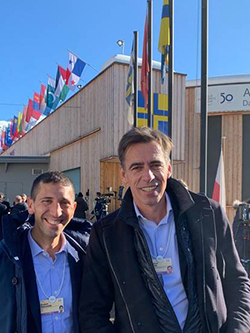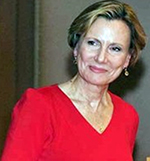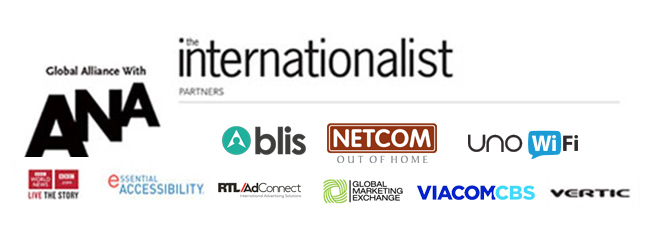

Rob Rakowitz and Stephan Loerke of the WFA at Davos debuting GARM as a Lighthouse Project by The World Economic Forum.
See the current issue
of The Internationalist magazine
Find out how to sponsor an issue of Trendsetters
|
|
If you have spotted a trend or given a recent presentation on a global issue, please tell use and don't forget a photo of yourself!

To submit to Trendsetters, contact me at: linkedin.com/in/deborah-malone-ab5897,
The Internationalist group on LinkedIn:
https://www.linkedin.com/groups/2560753/or at Twitter--@DMaloneIntl
Trendsetters: Rob Rakowitz Outlines at Davos New Actions from the Global Alliance for Responsible Media
The Internationalist Trendsetters is written by Deborah Malone, founder of The Internationalist.
As appealing as it may be for brands to increase their online reach in a world with 1.2 zettabytes per year of internet traffic, digital advertising can sometimes go wrong. Brand safety has quickly become a critical issue for marketers and the companies they serve—and for good reason. Multiple surveys now state that roughly half of consumers would rethink purchasing-- or even boycotting a brand-- if it appeared next to content that offends or concerns them.
Last week at Davos, The Global Alliance for Responsible Media (GARM) unveiled its strategy to create a more sustainable and responsible digital environment that protects consumers, the media industry and society.
The Alliance was founded by members of the World Federation of Advertisers (WFA) and is also championed by the ANA CMO Growth Council. Formed just six month ago, GARM's role is to identify specific collaborative actions, processes and protocols for protecting consumers and brands from safety issues. The goal is to work toward a media environment where hate speech, bullying and disinformation is challenged, where personal data is protected and used responsibly when provided, and where everyone-- especially children-- is better protected online.
The initiative brings together an unprecedented coalition of 39 advertisers, six agency holding companies, seven leading media platforms and seven industry associations—which collectively represent $97 billion in global advertising spending.
According to Rob Rakowitz, Initiative Lead for the WFA Global Alliance for Responsible Media, and well-known for driving a successful 5-year media transformation for Mars Inc., "Previous approaches to harmful content have been in part a reactive game of 'whack-a-mole.' We are convinced this uncommon collaboration is what is needed to change the game. Since our launch in June, we've made significant progress to raise the bar in terms of identifying and eliminating content uploaded by bad actors, for the benefit of brands, people and society at large."
The WFA reports that between July and September 2019, an estimated 620 million pieces of harmful content were removed by YouTube, Facebook and Instagram. Rakowitz continues, "Because of the platforms' investments in teams and tools, most of this content was removed before it reached consumers. However, approximately 9.2 million pieces of harmful content did appear during that 3-month period, equating to roughly one piece of harmful content viewed per second. GARM is taking action, through our collaborative approach, to protecting the four billlon consumers online today, with the goal of eliminating harmful online content and ensuring that bad actors have no access to advertiser funding."
In addition to being profiled as a Lighthouse Project by the World Economic Forum, a series that spotlights the ways in which stakeholders are making concrete progress to address the biggest challenges of our time, GARM has been officially recognized as a key project for 2020 within the WEF's platform on Shaping the Future of Media Entertainment and Culture.
Stephan Loerke, Chief Executive Officer of WFA commented, "Advertisers can play a unique role in improving the digital ecosystem that we all want to enjoy. Given that brands fund many of the platforms and content providers, we can ensure society gets the benefits of connectivity without the downsides that have sadly also emerged. These first steps by the GARM are a significant move in the right direction, which will benefit consumers, society and brands. I'm delighted that the WFA has played such a key role in corralling the different actors of the digital ecosystem behind such a compelling common action plan."
The coalition has been formed with support from the following:
- Executives from Adidas, Asahi Beer, Bank of America, Bayer, Beiersdorf, BP, Chanel, Danone, Diageo, Discover, EA, Ferrero, Fiat Chrysler, Friesland Campina, General Mills, GM, GSK, Hershey, HP, Johnson & Johnson, Kellogg, LEGO, LVMH, Mars Incorporated, MasterCard, Microsoft, Mondelez International, NBC Universal, Nestle, Orange, Procter & Gamble, PepsiCo, Pernod Ricard, Philips, Shell, Sony, Unilever, Vodafone, Yildiz Holdings and Yum! Brands
- Experts at Dentsu, GroupM, Havas Media, IPG, Publicis Media, and Omnicom Media Group-- representing media agencies
- Media companies and platforms consisting of Facebook, Google/YouTube, Teads, TRUSTX, Twitter, Unruly, and Verizon Media
- Supporting industry associations including ANA, 4A's, Interactive Advertising Bureau, ISBA, Mobile Marketing Association, Coalition for Better Ads, Effie Worldwide and the WFA's local advertising association members.
GARM's strategy is a major step forward in improving safety across the media supply chain. The long-term vision of the Alliance is to drive growth and connectivity for society on ad-supported media platforms-- in order to foster and enable civil dialogue. It is committed to taking further bold steps to eliminate harmful content by complementing the approaches that have been taken by governments and online platforms.
GARM is operating with a three-pronged action plan:
Shared Definitions: The Alliance has developed and will adopt common definitions to ensure that the advertising industry is categorizing harmful content in the same way. The 11 key definitions covering areas such as explicit content, drugs, spam and terrorism will enable platforms, agencies and advertisers to a shared understanding of what is harmful content and how to protect vulnerable audiences, such as children. Establishing these standards is the first step needed to stop harmful content from being monetized through advertising.
Common Tools and Systems: The Alliance will develop and adopt common tools that will create better links across advertiser controls, media agencies tools, and the platform efforts to categorize content. Creating these linkages will improve transparency and accuracy in how media investments are steered towards safer consumer experiences – in images, videos and editorial comments.
Independent Oversight: The Alliance will establish shared measurement standards so that the industry and platforms can fairly assess their ability to block, demonetize, and take down harmful content. Transparency via common measures, methodology for advertisers, agencies and platforms is key to guiding actions that enhance safety for consumers. Adopting key measures and agreeing to independent verification will be key to driving improvement for all parties, which we will look to track annually. A special working group from the GARM will be activating this strategy starting in April.
WFA connects the world's biggest brand owners and national advertiser associations in more than 60 markets, bringing together tens of thousands of brands at local level. Together, they create a global network which offers a unique source of leadership, expertise and inspiration. More at www.wfanet.org
